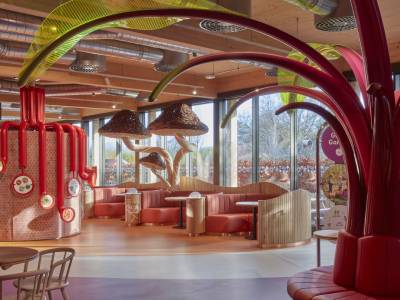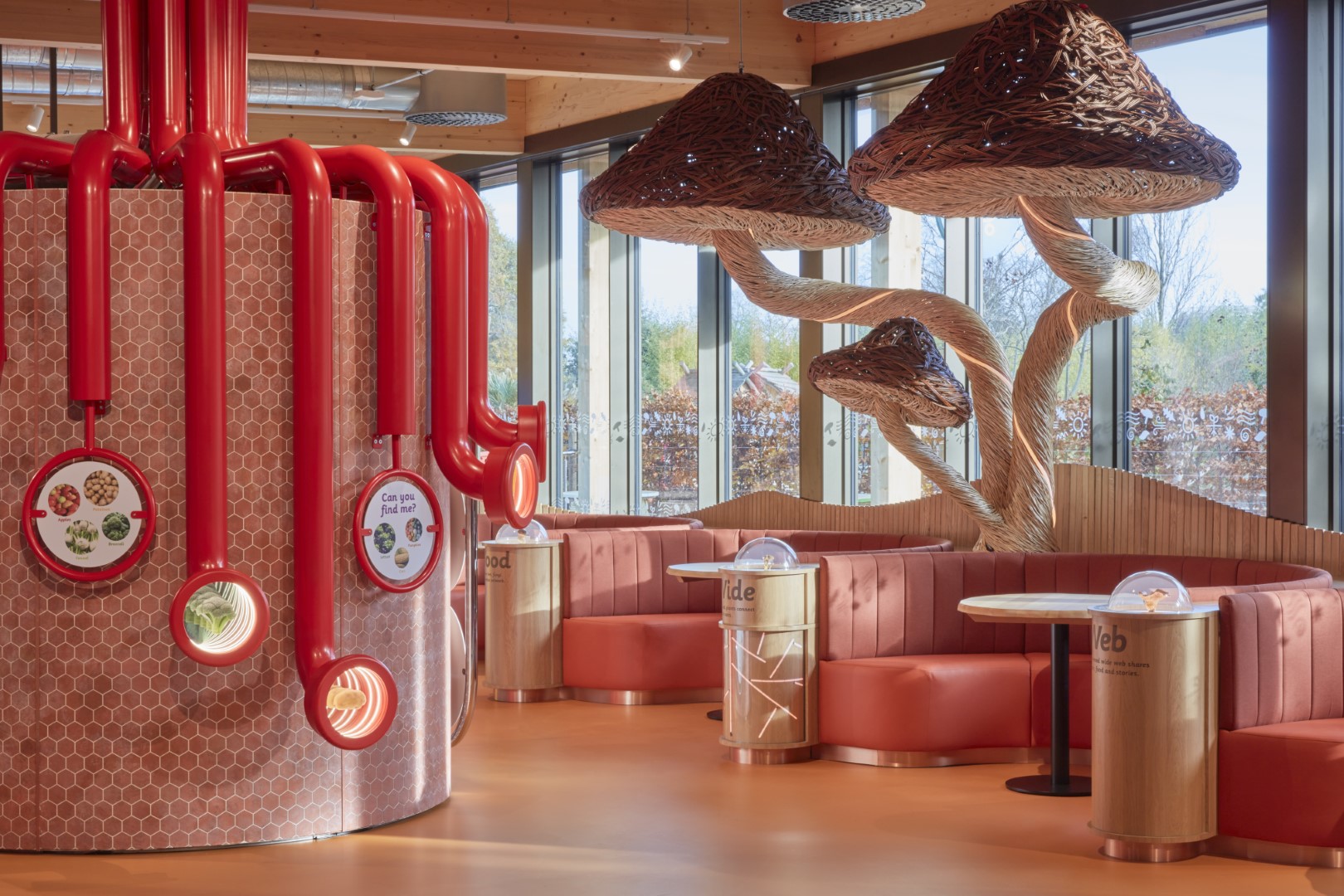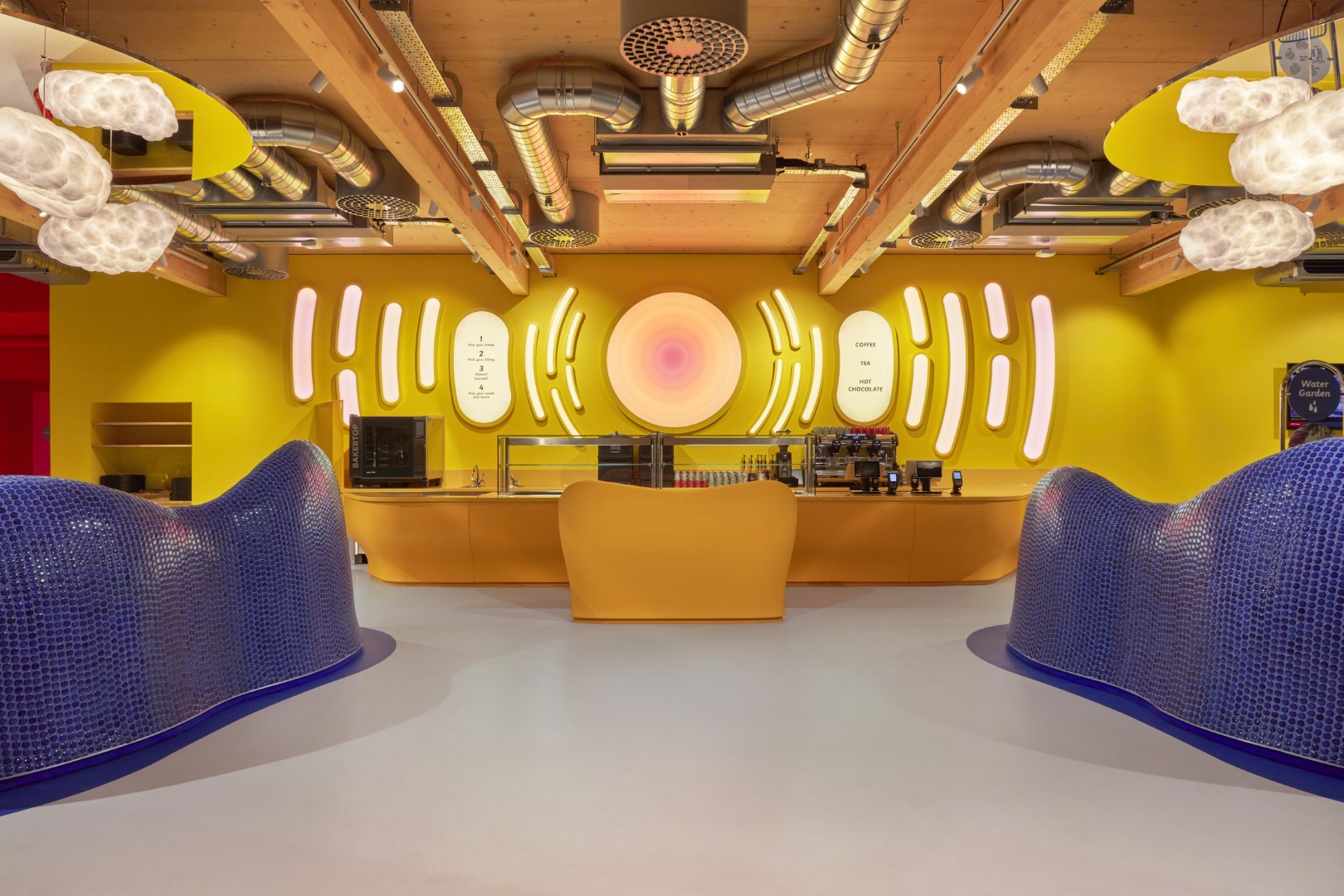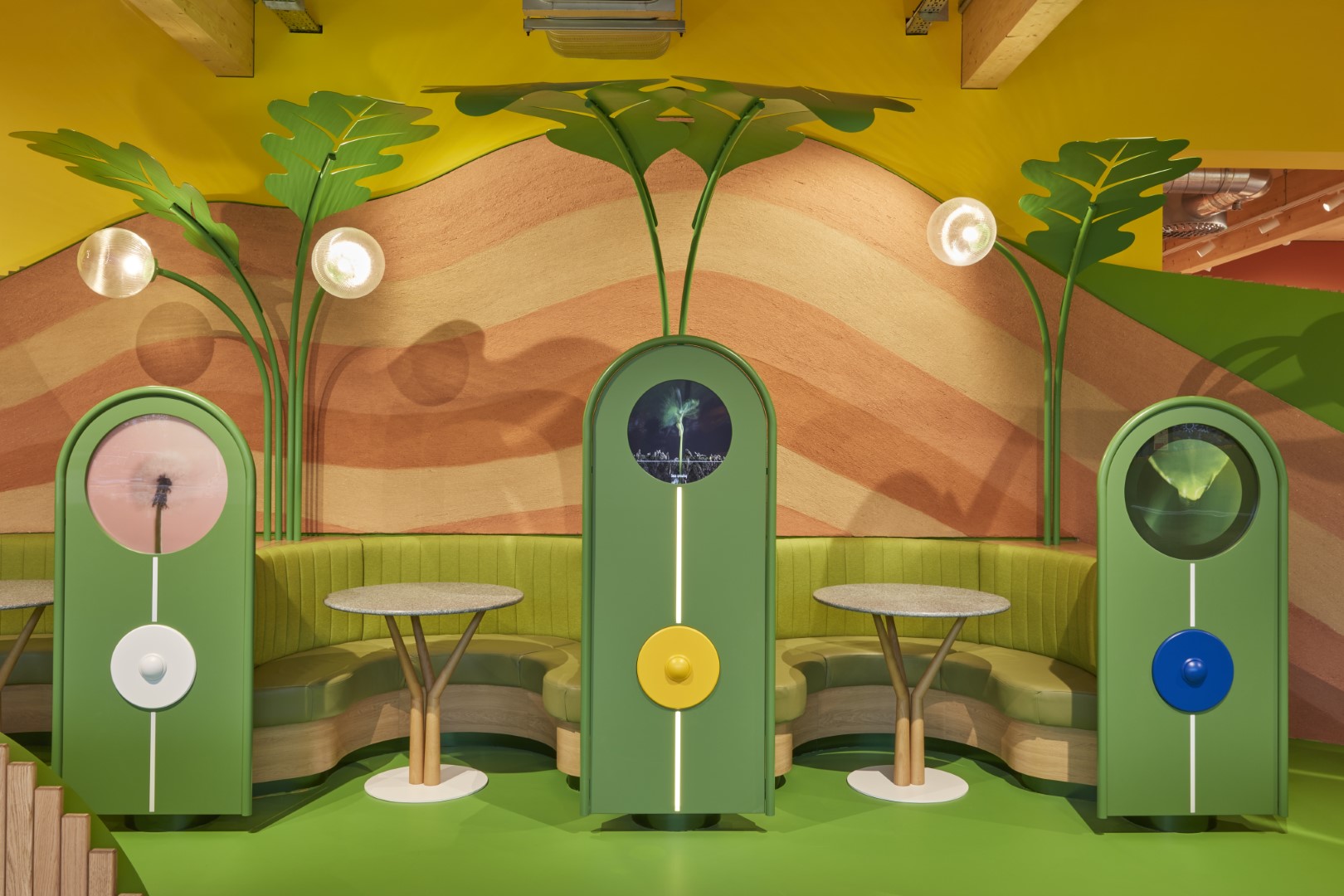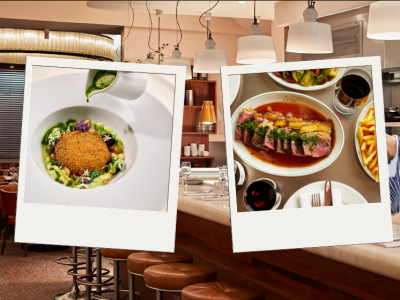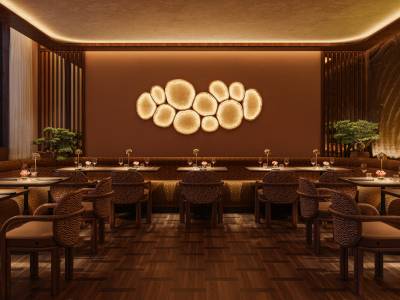“What did Willy Wonka get wrong?” ponders designer Jonathan Mizzi. “Well, his factory was a non-inclusive, closed-box factory that nobody could see unless they won a golden ticket!” Mizzi, the charismatic British/Maltese director his namesake studio, has created a space in London inspired by Roald Dahl’s most beloved creation (albeit without the glass elevator, stringent quality control squirrels and the enslaved indigenous tribe).
Having in the past built such elegant installations as the Royal Parks kiosks, the bulbous Chiswick house in Malta and the spa in the Mondrian. This spring will be the perfect time to experience the new Kew Family Kitchen, a delightful new space in which you can dine inside an apple, peer into a periscope to check on your pizza ingredients. Inspired by both big screen Wonka’s (Wilder and Depp) as well as Honey I Shrunk The Kids and Alice in Wonderland. “From the start we wanted to build a visual story for Kew that placed families at the heart of the narrative – protagonists in a story of overgrown plants, vegetables, seeds and fungi. Kew was completely on board with our vision of creating a nature-fuelled ‘imaginarium’ from the start. Ultimately, our idea was to blow nature up to heroic proportions, so that humans could walk amongst it at the scale of tiny creatures.”
Kew Family Kitchen is worthy of Wonka
29th March 2022
Meeting the innovative mind behind Kew Gardens extraordinary new family space.
What was the most unusual plant you saw inside Kew when you were doing your initial research?
Kew is a treasure throve of unusual, awe-inspiring flora and fauna. We did get very specific with some of the design elements within the space, mirroring the lessons we had learnt from the species being studied within the grounds. For example, in the Kitchen’s Giant Garden, a central Enset seat takes biomimetic references from the False Banana or 'Enset' – a food crop in Ethiopia that Kew researchers have dubbed 'the tree against hunger' for its potential to feed 100 million across Africa. We used this whimsical seating design to showcase the unity between our project and the wider context of Kew’s activity and research.
What was technically the hardest thing to get right in the Kew Gardens restaurant?
We needed to seat 250 diners whilst ensuring we designed a space that embodied a ‘nature meets interactive food lab’ approach – a restaurant that would teach visitors the role of plants and the elements in our food cycle. We used colour to solve this problem. Our team created distinct zones within the space, each corresponding with seasonal food stories. Echoing the nearby Children’s Garden, these interactive areas included a Spring Garden, Water Garden, and Giant Autumn Garden.
How long did it take to build each of the apple-shaped seat, fungi sculpture and Ethiopian Enset tree?
These design elements took roughly two to three months each, but all were built off-site and built over a couple of days. We work through sampling and prototyping, ensuring quality is at its highest. These were primary features, so they needed time to develop. More importantly, we champion low-carbon materials – such as the timber used in the apple seating and mushroom sculptures. We also prioritise modular and pre-fabricated elements in all our work – this means greater efficiency and a minimised carbon impact. Speed is secondary to making sure our designs are as sustainably made as possible.
What has been the most surprising reaction to the cafe that you’ve seen from either a child or an adult?
The reactions from visitors have been so encouraging and positive. We recently invited children to come to the space and give their commentary around what they experienced. It was so great to hear that the main takeaway for them was that they learnt so much more about the food they were eating than in any of their other daily circumstances. One of the young boys that visited commented on how he “just learnt about the seeds – it’s really cool how they sprout”. Another child said that at home she “wouldn’t really think about the food she was eating,” but that within the Family Kitchen she was able to “explore and learn about different things” to do with the way families consume their daily meals. That spirit of entertainment-meets-education was really important for us to get right, so reactions like this are truly uplifting.
What design trend do you see getting bigger in 2022?
We are less interested in trends and more so in the complete transformation of the industry into a carbon-neutral, regenerative profession. The architecture and design industry has very recently seen a massive shift in practice towards trends that favour a nature-led approach. Mizzi Studio has been focused on this philosophy since day one of our foundation. Our architecture holds the natural world as its greatest teacher and inspiration. Nature never goes out of style and is far more powerful than any trend we might pick up and later discard along the way. Our team has always used biomimicry and zoomorphism to push forward our ideas around nature-led architecture. We use these approaches not just as visual exercises, but because reflecting organic patterns in man-made structures has proven to have a positive impact on human beings. The second principle we have been known to lead with is biophilia, which goes a step beyond the ‘form’ of buildings and the way they look. Biophilic design looks to connect people who inhabit buildings and spaces more closely to nature. Biophilic buildings prioritise natural lighting and ventilation, a connection to green space, and in our case, a preference for natural materials wherever possible.
Which international city are you keen to visit?
The truth is I would like to spend less time in cities and more in nature, but I’m keen to visit cities such as Singapore, that are spending a lot of energy on greening their city – Singapore is known as the world’s greenest city, nicknamed the ‘city in a garden’. The importance of re-wilding our cities has become central to our own practice, re-establishing wildlife corridors and reintegrating flora and fauna. We can’t live in harmony unless we are connected to nature.
Which interior brands do you collect and have in your own home?
Before moving back to Malta, we made our own bamboo living wall for our London apartment by importing beautiful, long bamboo from Sumatra. We also found a gorgeous original Sixties G Plan desk on the street, and we have an early prototype of Mizzi Studio’s own Awkward table, where the curved legs capture the balance and strength of the Bikram yoga Awkward pose.
Which contemporary artists inspire you?
Art, design and material geniuses like Ibuku Studio, Neri Oxman and Antoni Gaudí are big influences. But nowadays I spend more time listening, reading and watching the work of the world’s most important environmentalists. Jane Goodall and David Attenborough, for example, are heroes that I believe the design world has so much to learn from.
Who is the next big thing in the world of design?
There is no option not to consider the environment and climate change in any and every human endeavour or activity going forward. We are living in a climate emergency and therefore must design everything we produce – from buildings to products of all scales – in the context of that emergency. So anyone who is doing the most to address the issue of climate change is the next big thing. We are also a studio that works consistently on speculative and research-based projects. We continue to carry out research on how bio-architecture can help design humanity out of a climate crisis – that is possibly the most exciting prospect we could ever hope to work on.

